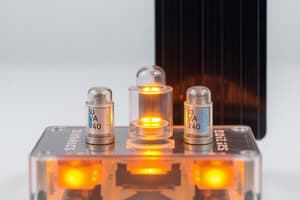Podcast
Questions and Answers
What is the recommended method for completing the assessment for Unit B2 Lab?
What is the recommended method for completing the assessment for Unit B2 Lab?
- Fill it out online without any hand-written work.
- Print the assessment and write answers by hand. (correct)
- Complete it digitally using a stylus only.
- Use a scanning app and upload directly to D2L.
Which of the following is NOT one of the options for submitting the assessment?
Which of the following is NOT one of the options for submitting the assessment?
- Using a scanning app to create a PDF file.
- Uploading it to the assigned folder on D2L.
- Submitting work in a digital format without photos. (correct)
- Using a scanner to scan work.
Which statement is accurate regarding the balancing of chemical equations in the assessment?
Which statement is accurate regarding the balancing of chemical equations in the assessment?
- Balancing is optional for all equations.
- Materials do not require states of matter notation.
- Equations must include states of matter. (correct)
- Only half of the equations need balancing.
What should be done if using a digital method for the assessment is chosen?
What should be done if using a digital method for the assessment is chosen?
When uploading the assignment, how should the pages be organized?
When uploading the assignment, how should the pages be organized?
In which cell does oxidation occur at the anode?
In which cell does oxidation occur at the anode?
What is true about the reduction half-reaction in Cell 2?
What is true about the reduction half-reaction in Cell 2?
Which cell has Mg(s) as the anode?
Which cell has Mg(s) as the anode?
In Cell 6, what is the standard cell potential likely to be?
In Cell 6, what is the standard cell potential likely to be?
In which cell does the reduction half-reaction involve Cu2+(aq)?
In which cell does the reduction half-reaction involve Cu2+(aq)?
Which half-reaction corresponds to the oxidation process in Cell 4?
Which half-reaction corresponds to the oxidation process in Cell 4?
Which cell has both metals in the same oxidation state?
Which cell has both metals in the same oxidation state?
What is true about the net cell reaction in Cell 5?
What is true about the net cell reaction in Cell 5?
Flashcards
Voltaic Cell Lab
Voltaic Cell Lab
A laboratory activity focusing on oxidation-reduction principles in electrochemical cells.
Oxidation-Reduction
Oxidation-Reduction
Chemical reactions involving electron transfer.
Electrochemical Cell
Electrochemical Cell
A device that converts chemical energy into electrical energy.
Assessment Submission
Assessment Submission
Signup and view all the flashcards
PDF File Format
PDF File Format
Signup and view all the flashcards
Anode
Anode
Signup and view all the flashcards
Cathode
Cathode
Signup and view all the flashcards
Oxidation Half-Reaction
Oxidation Half-Reaction
Signup and view all the flashcards
Reduction Half-Reaction
Reduction Half-Reaction
Signup and view all the flashcards
Net Cell Reaction
Net Cell Reaction
Signup and view all the flashcards
Standard Cell Potential (E°)
Standard Cell Potential (E°)
Signup and view all the flashcards
Observed Cell Potential (E)
Observed Cell Potential (E)
Signup and view all the flashcards
Predict the Cell Potential
Predict the Cell Potential
Signup and view all the flashcards
Study Notes
Unit B2 Lab: Building a Voltaic Cell
- This assignment applies oxidation-reduction principles to electrochemical cells.
- Chemical formulas and equations should include states of matter.
- Balancing chemical equations is required when needed.
- Completing the assessment by hand is recommended.
- Print the template and write answers.
- Digital completion is possible but less recommended due to equation editor's time consumption.
- Submit a single PDF file of the assignment pages, ensuring they are in order and readable.
- Scan using apps like Adobe Scan or CamScanner.
- Use a scanner.
- Complete using a stylus and tablet.
- Upload the file to the "Unit B2 Lab" assignment folder in D2L.
Observations and Cells (Page 2)
- Various electrochemical cell observations are provided for different cells.
- Each cell includes anode, cathode, reduction half-reactions, oxidation half-reactions, net cell reactions, predicted standard cell potentials, and observed cell potentials.
- Example cell configurations like Zn(s) | Zn2+(aq) || Cu2+(aq) | Cu(s) are listed.
Drawing Voltaic Cell Diagrams (Page 3)
- Students must draw diagrams of two cells from a virtual lab.
- Include beakers, salt bridge, wires, voltmeter, anode, and cathode.
- Label anode and cathode components.
- Indicate the direction of electron flow.
- Show the movement of cations and anions.
- Diagrams cannot be copied from the internet.
Comparisons and Considerations (Page 4)
- Compare predicted and observed cell potentials, noting discrepancies.
- Possible reasons for differences include solution concentration, temperature variations, and electrode limitations.
- Small voltaic cells were used to reduce chemical handling.
- Increased cell size won't impact equilibrium but may affect rate or output.
- Ni-Cd cell potential calculation example: Anode potential = Cell potential − Cathode potential (Example: Anode = 1.30V - 0.49V = 0.81V).
Studying That Suits You
Use AI to generate personalized quizzes and flashcards to suit your learning preferences.




